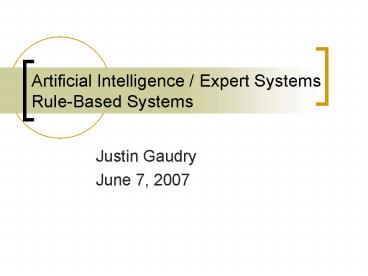Artificial Intelligence Expert Systems RuleBased Systems - PowerPoint PPT Presentation
1 / 12
Title:
Artificial Intelligence Expert Systems RuleBased Systems
Description:
Start from conclusion and show logical path backward to true antecedents. Goal-driven reasoning ... something barks, it is a dog. Dogs are not cows. Example: ... – PowerPoint PPT presentation
Number of Views:190
Avg rating:3.0/5.0
Title: Artificial Intelligence Expert Systems RuleBased Systems
1
Artificial Intelligence / Expert
SystemsRule-Based Systems
- Justin Gaudry
- June 7, 2007
2
Rules
- Ifthen structure
- Antecedent -gt Consequent
- Hypothesis -gt Conclusion
- Antecedent tests an object with a possible value
- Consequent is action to take place when
antecedent conditions are met or fact to be added
to current set
3
Types of Rules
- Recommendation
- Gives advice
- Maybe you should
- Could be this
- Directive
- Perform an action
- Relational
- Demonstrates relationship between two objects or
object and characteristic
4
Production Systems
- Most common form of expert system
- Use rules to provide recommendations, determine
course of action, or solve a problem
5
Production Systems
- Knowledge base set of rules
- Knowledge of the system represented in the rules
- Working memory set of facts
- Starts with premises, adds new intermediate
conclusions and perhaps removes old ones - Inference engine aka interpreter
- Procedure by which rules are identified or
triggered and action fired
6
Conflict Resolution
- Resolution necessary when several rules are
triggered at the same time - Some priority hierarchy must be developed
- Heuristic priority levels
- Rule with highest preassigned value wins
- If-elseif
- Longest-matching strategy
- Rule with most positive factors in antecedent
wins - More specific
- Temporal strategy
- Rule with most recent factors added to working
memory wins
7
Chaining
- Forward chaining
- Using deductive reasoning to derive new
intermediate conclusions from existing facts and
make them new facts - Data-driven reasoning
- Uncertain goal
- Present to future
- Breadth-first search facilitated
- Explanation not facilitated
8
Chaining
- Backward chaining
- Start from conclusion and show logical path
backward to true antecedents - Goal-driven reasoning
- Must have a clear and known goal
- Present to past
- Depth-first search facilitated
- Explanation facilitated
9
Forward Chaining
- Add premises to working memory
- While more rules can be fired (and possibly
satisfactory conclusion has not been reached) - Fire rule
- Add new facts to working memory
- Endwhile
10
Backward Chaining
- Add conclusion to facts to be proved.
- While more to be proved and more rules can be
found - If current fact is a conclusion to a rule
- Add rule hypothesis (es) to facts to be proved
- Endif
- Endwhile
11
Example Rules
- If something has spots, it is a Hereford.
- A Hereford is a cow.
- If something is a Hereford, it does not bark.
- If something has spots, it is an animal.
- If something barks, it is a dog.
- Dogs are not cows.
12
Example Facts
- Fido has spots.
- What new information can be added?
- Fido just barked.
- What new information can be added? Removed?
- Conclusion Fido is a dog.












![Artificial Intelligence Lecture 8: [Part I]: Selected Topics on Knowledge Representation PowerPoint PPT Presentation](https://s3.amazonaws.com/images.powershow.com/7421234.th0.jpg?_=20151128083)


![ARTIFICIAL INTELLIGENCE [INTELLIGENT AGENTS PARADIGM] PowerPoint PPT Presentation](https://s3.amazonaws.com/images.powershow.com/8134330.th0.jpg?_=20160919108)















